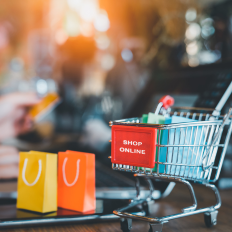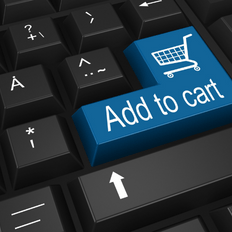Multi-channel, social media, personalized, order online, in-store, whenever, wherever you like. This is the reality of retail today. The question is how do retailers create shopping experiences which bring all these components together, to create a coherent, seamless eCommerce shopping experience? Welcome to Omni-channel retailing, the paradigm shift which requires retailers to pay attention.
Omni-channel retailing is a real change in the way in which the retail experience is viewed, to understand it fully we need to answer some significant questions.
⚓ So what is omni-channel retailing?
⚓ What does omni-channel look like in the real world?
⚓ How is consumer behaviour driving the rise of omni-channel?
⚓ Why consumers love omni-channel
⚓ Speed and convenience: omni channel order management, the missing piece of the puzzle?
⚓ Why there’s a need for omni-channel order management?
⚓ Benefits to consumer of omni-channel order management
⚓ Benefits of omni-channel to retailers
So What is Omni-channel retailing?
With so many different aspects to delivering an omni-channel experience it comes as no surprise that defining what exactly it is can be a challenge. So what’s the difference between multi-channel retailing and omni-channel retailing?
Omni-channel revolves around your customer and creates a single customer experience across your brand by unifying sales and marketing that accounts for the spillover between channels.
Shopify Team
Big Commerce believes multi-channel retailing means ‘a company sells in multiple online channels e.g. a web store, marketplaces, and social media. Omni-channel refers to retailers with both a physical and digital presence.’
All omni-channel experiences will use multiple channels, but not all multi-channel experiences are omni-channel (Blogspot).
Instead of thinking about different digital channels providing different experiences, we need to start thinking about things holistically. Most retailers utilize a multi-channel approach, but that doesn’t mean you’re an omni-channel retailer. You can have an award-winning website, standout social media channels, and a beautiful store, but if they’re not working together it’s not omni-channel.
So What Does Omni-Channel Retailing Look like in the Real World?
It’s the night before Christmas eve, and all is quiet in the Grovner household. All parties have arrived safely from their respective starting points. Pleasantries exchanged, unpacking vehicles completed and food consumed, the family sit down to relax. Suddenly, Dad realizes he’s forgotten little Tim’s present! Frantically he grabs his phone from his pocket, and remembering a Facebook ad for a toy Tim wants, he starts scanning Amazon. From Amazon he’s directed to the website of an independent retailer, just then disaster strikes, his phone dies! Dad takes to his laptop and completes his order, choosing to select the buy online pick up in store option (BOPIS). Little Tim receives his Christmas present, and Dad saves the day.

Now, as cozy as our Christmas Story is, What Does it Show us? And How is Consumer Behaviour Driving the Rise of Omni-Channel?
Omni-channel is about having a cohesive user experience at all touch points, with consistent ‘messaging, goals, objectives, and design across each channel and device’ (Blogspot). Consumers are looking for seamless online and instore experiences, and if they’re not satisfied with the experience they WILL go elsewhere. Companies with weak omni-channel strategy retain only 33% of customers, compared to 89% of businesses with strong strategies (Veeqo). This includes order management, the shopping experience does not end after the customer has placed the order, it doesn’t even end on order fulfillment. Returns, future purchases, recommendations-this is customer centered retail, the omni-centered approach.
Known as the ‘Netflix effect’ Consumers now expect to be able to start a purchase or browse on one device and complete orders on another device, with 59% saying it affects how they shop.
IBM MediaCenter
Two thirds of consumers are now considered as being omni-channel users (Advansys). Grannies, Grandpa’s, Mums, Dads and kids are all involved and of these groups it’s younger people make up the vast majority. Generation Z (18-22) and Millennials (22-37) who are driving the rise of omni-channel retail. But why?
‘The Omni-Channel Retail Report’ by BigCommerce shows where and why omni-channel going where it is. They found the Gen Z, who make up 2.5 billion online customers, and are the biggest users of omni-channel retailing have huge ‘economic influence on family and wider community’, older generations are looking towards younger generations because they know they’re upto date with the latest trends, and deals. So what exactly is it Gen Z want?
There’s no surprise that convenience, price, and free shipping are the three top reasons across the board for purchasing products online. When we look at Millennials, personalized shopper experience is key, but with Gen Z who have never known any different, they want more, they want experiential (Forbes) shopping experiences with real social value (Forbes/The Marketing Scope). We can’t tell you about price and free shipping, but we can talk about how omni-channel excel at experience, personalization, social value and convenience.
Why Consumers Love Omni-Channel? And How it’s Achieved

- Experiential.
The lines between retail and other online and instore experiences are becoming increasingly blurred, according to SDWN Solutions ‘expect everything from instore cafes to free charging hubs, man dens to streamed TV, augmented reality, virtual reality, holograms, smart mirrors.’ Customers want more than a simple purchase, they want an experience. According to a report by AnnaLect over half of Millennials believe that a brand’s use of tech was more important than its name. - Personalized shopping starts with a sign-up, whether through email or Facebook this is where personalization begins.
Exclusive offers, exclusive content, ability to purchase through apps, updates on when customers should reorder/ refill. All this goes into making the personalized experience.
A great example of this is Chipotle, who after sign up gives exclusive content to members on recipes and nutritional advice. Their app also allows customers to find nearest restaurants, and place bespoke orders, now that’s customer service! What personalized shopping also enables is access to a level of convenience (one of the top five reasons for purchasing), not ordinarily available to non-members, all the more reason to go omni-channel. - Social value and social sharing.
Online retail is now about more than selling, it’s about what social value is attached to your products and company. Millennials and Gen Z want to know about corporate social responsibility, they want to know about whether your brand has ‘lifestyle affinity’.
A great example of this is Leesa who provides regular video updates on their website about their work with a non-profit who helps reunite families. And if your values match with theirs, customers will share. A prime example of this is Undies underwear who promote ‘positive body image’ by suggesting members post pictures to their Instagram page of customers in their new fancy underwear. - Convenience…
Speed and Convenience: Omni Channel Order Management, the missing piece of the puzzle?
Now it doesn’t matter if you have a beautiful website, personalized, socially conscious marketing, engagement with Millennials, Gen Z and everyone in between, if you can’t get orders right.
Order management has become the new retail paradigm and the enabler to holistic eCommerce strategy.
Radial
To match the all singing all dancing omni-channel browser experience, you need an order management system that’s up to the task. Remember omni-channel retailing is about the system, not individual components operating independently. According to Radial ‘order management has become the new retail paradigm and the enabler to holistic eCommerce strategy’. So what’s the difference between a simple Order Management System and Omni-Channel Order Management (OCOM)?
Organizational Integration
OCOM encopases; inventory management, warehouse management and order fulfillment. This type of system is about unifying different processes, across different channels, and different operations. To do this order and CRM systems need to integrate with inventory management systems. A sleek data automation system is required to centralize all processes and provide your sales team, customer service personnel, warehouse operatives and delivery drivers the tools they need to provide excellent customer service.
Inventory visibility
With integration comes increased visibility. A truly integrated system is centralized and should provide visibility to data on sales, inventories, shipping data and returns (SkyNexus). A further bonus of having a centralized system is having information that is on time and up to date, allowing for real time decision making which is made with confidence.
Why there’s a need for Omni-channel order management?
Previous ‘simple order management systems’, with their lack of centralization, manual data input and poor visibility are simply not up to task when we’re considering the seamless user experience required by omni-channel retail. Common issues include;
- Mismatched stock, resulting in delayed speed of delivery.
- Conflicts with other channels due to poor communication.
- Inefficiency due to human error, resulting again in delayed fulfillment. (Oracle)
Benefits to Consumer of Omni-channel Order Management
If you remember back to reasons why people make purchases-convenience is big indicator across all age groups. With the centralised nature of OCOM systems, inventory visibility is increased and this opens serious of exciting options for retailer and consumer, with amazing knock on benefits. These are things you just can’t do, and achieve with a simple order management system. Once you’ve downloaded the retailers app, customers are able to see stock in real time, they can buy online, and pick up in store (BOPIS) or even click and collect at a different location. Why’s this so good? This access to great control has far reaching benefits and these benefits just happen to be three of the key markers for consumers to make purchases.
- Firstly the customer gets a sense of personalization, they have options and they can choose.
- Secondly, this system provides a serious level of convenience, the customer chooses where and when their purchase will be, increasing customer satisfaction.
- Convenience and speed. ‘The Amazon Effect’ has been noted as the desire of customers to receive orders within two days with automated data system, order fulfillment is speeded up.
- People like free shipping and if the customer chooses instore pick there’s no shipping cost, simple!
Why Online Retailers NEED to Invest in Omni-Channel retailing
Omni-channel Order Management is just too good.
As mentioned before there’s no point in having seamless browser experience if fulfillment isn’t working. The knock-on effects of having a centralised system cannot be overstated. From personalisation, to convenience to free shipping-this is big! How big?
- Efficiency increases as staff have tools that they can easily operate, and allow for less errors and faster turnaround (Netsuite)
- Shipping efficiency.Moving to a smart supply chain means increasing shipment accuracy from 31% to a staggering 99% (SDC).
- Labour productivity increases inline with automation (Havard Business Review).
- Increase data security
- Transparency in reverse logistics, otherwise known as returns. 15% of customers will abandon a brand after a poor returns experience (Narvar).
- Centralised systems require less in house training of staff.
- By providing a centralised system, with high visibility, customers can be offered options such as click and collect, and buy online pick up in store (BOPIS). 47% of Home Dept orders are now in store.
- 37% make additional purchases when collecting online purchases in store (Tecsys)
Omni-channel customers will stay with you and buy more
Remember companies with strong omni-channel strategies retain 89% of customers, where as those with weak strategies loose 69% of customers (Veqoo). Alongside this, customer satisfaction is 23x higher, yes 23x higher with companies who have a omni-channel strategy (Aberdeen).
With more touch points, there is more interaction with customers, and chances to sell. Consider the influence of Gen Z. Once a customer has been through your channels and experienced your first class omni-channel retail experience, with retention rates and customer satisfaction so high, they’re u likely to be going back to old days of clunky multi-channel.
Personalisation = repeat business
A key aspect to omni-channel retail is personalization, and how is this achieved, generally though loyalty schemes, exclusive content, updates on new products. All this allows increased convenience and the feeling that you’re being looked after the brand you adore. Would you walk away from a curated experience, which offers this kind of experience?
Greater engagement = Seamless efficient marketing
With greater engagement across different channels there is a huge opportunity to gather data and understand your customers’ behavior. 62% of consumers who engage in 10 or more channels, make weekly purchases (Veqoo). If you understand how your channels are being used, and by what demographic you can allocate resources where they are most needed. Reducing waste and converting more sales. Personalization is key to omni-channel.
Brand awareness and brand message
Have you shared something online today? We all do it, it used to be word of mouth, you’ve seen something you like in the shop on the highstreet and you tell your friends. Now there’s multiple channels, and speed is of the essence. When you understand how important social consciousness and meaning are to omni-channel customers you understand the need for a cohesive brand message (Forbes). If you have a strong brand identity and message, the beauty of omni-channel is your message will be spread far and wide.
It’s fairly clear that online retail is moving towards omni-channel, quickly. Should businesses engage with every piece available technology, to elevate their online retail experience, providing first class omni level service? Not all businesses have the resources.
It really is a complicated picture, and if you don’t have the capital to invest don’t spread yourself too thinly. What is clear, is that since the start of the Coronavirus and subsequent lockdown, there has been a 31% surge in online sales (Digital eCommerce) and people will continue to make use of innovative online retailer services. Take the messages; convenience, personalized, experiential, social, think about it. How can you start thinking of the whole system, communicate better, and provide a retail experience that consumers will increasingly want?




